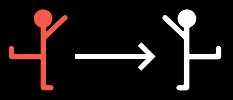"♫ Spin that wheel! ♫"
 |
Publisher:
Ammonite Press (https://www.ammonitepress.com/)
Author:
"Ormond Sacker" (possibly Viv Croot?)
Illustrator:
Tobias Willa
# of Players:
1
Game Design & Mechanics
- Let's start with the most in-your-face, eye-catching characteristic of the book: there's a code wheel embedded right in its cover. It lets you convert either a letter or a dancing man (a Sherlock classic) into a color and/or digit and/or different letter. Right now, a digital version of that code wheel is even available on the publisher's website.
- Beyond that, though, the book works like a classic "Choose Your Own Adventure" book, having you jump from one section to another. Although there are a few "traditional choices" to make, you can count those on just one hand. Most of the book follows the same pattern: reach a point where you need to solve a puzzle, figure it out, go to the right section, rince, repeat.
- A puzzle will either state "figure out a number and go that section", or give you a list of possible answers to choose from. Every section clearly states the section number(s) from which you could reach it, so it's easy to check whether or not you "guessed" correctly.
- In a few cases, making the wrong choice / guess won't really make a difference. In other places, you'll get an immediate "game over" ending. You might also end progressing with the story, only to later find out you've missed on a clue (or gained a "fake" clue) which can now only lead you to failure.
- The book holds a dozen pictures. Some are linked to puzzles, others are just for show.
- There is no global time limit, but a couple puzzles come with a short (ex: 15 seconds) explicit time limit.
- There's a "Hints" section at the end of the book, followed by "Solutions". Those cover most of the puzzles, are detailed, and helpful.
 |
| Picture from the editor's website |
Pros
- The Code Wheel is fun to fiddle with. (No wonder they put it on the cover.)
- The book has a couple clever ideas.
Cons
- Some of the design choices seem somewhat counter-productive to me. If the player is supposed to (possibly) make a wrong choice and keep on playing, why provide hints and solutions for everything? Why provide an exhaustive list of every section leading to the one you're at, when this might spoil something?
- For most the book, you're being railroaded in a rather disappointing manner: you might notice a hidden message somewhere ("Oooh, the first letter of every word spells a number!"), but then the book will tell flatly: "Take the first letter of every word and go the number they spell." 🙄 The worst part is, there is a part where you need to think outside of the box, but after being dumbed-down for so long, you might just miss it.
- I didn't find the storyline engaging. The author seems to have done his/her research on Holmes, but this enthusiasm doesn't translate into a great story. Before playing this book, I'd just finished reading "Le Piège de Moriarty" from the French "Escape Book" series, and the contrast is obvious.
(Oh, and a side note: you want to create a good Sherlock Holmes mystery game? Do not make Holmes the main character. It just doesn't work. Holmes is supposed to be brilliant, all the time. That's hard to fit in an interactive setting. - The ink is very dark in some of the pictures, to the point I only ever was able to see some hidden symbols under broad daylight.
- There's a couple puzzles for which you'd be tempted to make photocopies. Unfortunately, the book binding makes that very hard to perform.
Erratum
- Section 58, "A Red Notebook", states that every fourth number is skipped, but the example doesn't really match the statement. So beyond page 4, it really is every fifth page being skipped (1-3, 5-8, 10-13, and so on).
- Section 90 has an incorrect symbol in its code. Please refer to the image below.
House Rules & Suggestions
- To get the most enjoyable experience, I'd suggest trying the following: try playing the book without using any hints (except if you get completely stuck not knowing where to go next). Then, assuming you fail, try again using only the Hints section, and if you fail once again, then use the Solutions.


No comments:
Post a Comment